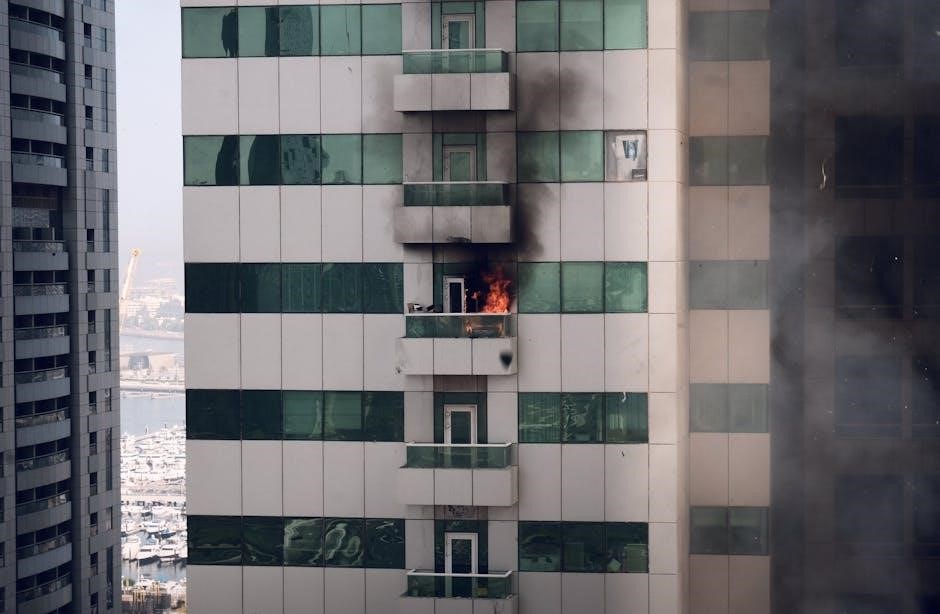Discover the captivating world of fire magic in A Witch’s Guide to Burning‚ a graphic novel by Aminder Dhaliwal. This spellbinding tale explores witches‚ fire rituals‚ and transformation‚ blending ancient practices with modern witchcraft. A must-read for those intrigued by the power of flames and magic.
Overview of the Concept of Burning in Witchcraft
Burning in witchcraft is a powerful and symbolic practice‚ often used for purification‚ transformation‚ and emotional release. It involves the intentional use of fire to cleanse spaces‚ objects‚ or energies‚ and to amplify magical intent. This practice is deeply rooted in historical witchcraft traditions‚ where fire was seen as a purifying force. Burning herbs‚ candles‚ or written intentions allows witches to release negativity and manifest change. It also serves as a metaphor for personal transformation‚ mirroring the cyclical nature of life and death. By harnessing the elemental energy of fire‚ witches can create meaningful rituals that align with their spiritual and magical goals. This ancient yet versatile practice remains a cornerstone in modern witchcraft.
The Importance of Fire in Magical Rituals
Fire holds a sacred place in magical rituals‚ symbolizing transformation‚ purification‚ and renewal. It is often used to amplify intentions‚ cleanse environments‚ and connect with elemental energies. In witchcraft‚ fire is believed to have the power to destroy negativity and foster growth‚ making it a central element in many spells and ceremonies. Rituals involving fire‚ such as burning herbs or candles‚ help witches focus their will and manifest change. This elemental force also serves as a bridge between the physical and spiritual realms‚ enhancing the effectiveness of magical practices. By incorporating fire into their rituals‚ witches can tap into its primal energy to achieve profound personal and spiritual transformation.
Historical Context of Witch Trials and Burning
The historical context of witch trials and burning reveals a dark period marked by fear‚ misunderstanding‚ and persecution. During the witch trials of the Middle Ages and early modern Europe‚ fire was often used as a brutal form of execution for accused witches. This practice stemmed from societal and religious beliefs that viewed witches as threats to order and morality. The use of fire symbolized purification and divine judgment‚ reflecting the era’s harsh attitudes toward perceived heresy. These trials highlight the intersection of magic‚ religion‚ and societal control‚ leaving a lasting impact on the perception of witchcraft. This history underscores the complex and often fraught relationship between fire and witchcraft‚ shaping modern interpretations of burning rituals in a contemporary context.

Understanding Fire in Witchcraft
Fire in witchcraft symbolizes transformation‚ purification‚ and renewal. It is a powerful elemental force used in rituals for cleansing‚ protection‚ and manifesting change‚ reflecting its deep magical significance.
The Elemental Significance of Fire
Fire holds profound elemental significance in witchcraft‚ symbolizing transformation‚ passion‚ and energy. It embodies the power to destroy and renew‚ making it a central element in rituals; Fire is often associated with the south‚ representing warmth‚ light‚ and vitality. Witches use fire to purify spaces‚ ignite intent‚ and connect with primal forces. Its flickering flames are believed to bridge the physical and spiritual realms‚ enhancing spellwork and divination. Fire’s transformative power mirrors life’s cycles‚ reminding practitioners of growth through adversity. This element is deeply revered for its ability to fuel change and inspire renewal‚ making it indispensable in magical practices.
Fire as a Purification Tool
Fire is a potent purification tool in witchcraft‚ used to cleanse spaces‚ objects‚ and energies. Burning herbs like sage or sweetgrass is a common practice to remove negative vibrations and restore balance. This ancient ritual‚ rooted in many cultures‚ harnesses fire’s transformative power to purify and protect. By consuming physical matter‚ fire symbolizes the destruction of impurities‚ allowing renewal and clarity.
Witches often use fire to cleanse magical tools‚ homes‚ or themselves before rituals. This practice not only removes stagnant energy but also prepares the environment for spellwork. Fire’s purifying properties make it a cornerstone in maintaining sacred spaces and promoting positive intent.
The Role of Fire in Transformation and Renewal
Fire holds a profound role in transformation and renewal within witchcraft‚ symbolizing change and rebirth. Through rituals like burning written intentions‚ witches release old patterns and manifest new beginnings. This practice mirrors the cyclical nature of life‚ where destruction precedes creation‚ allowing for personal and spiritual growth. The act of burning signifies letting go‚ enabling the emergence of renewed energy and purpose. By embracing fire’s transformative power‚ witches can navigate life’s challenges with resilience and hope‚ aligning with the elemental force that catalyzes profound change and fosters renewal on all levels.

Types of Burning in Witchcraft
Witchcraft encompasses various burning rituals‚ including herbs for purification‚ candles for spellwork‚ and written intentions to release negativity‚ each serving distinct magical and symbolic purposes.
Ritualistic Burning of Herbs and Plants
Ritualistic burning of herbs and plants is a powerful practice in witchcraft‚ often used for purification‚ protection‚ and manifestation. Herbs like sage‚ lavender‚ and chamomile are commonly burned to cleanse spaces‚ promote peace‚ and attract positive energy. This practice‚ rooted in ancient traditions‚ involves lighting the herbs and allowing the smoke to carry intentions into the universe. Many witches prepare the herbs by drying and blessing them before burning‚ ensuring their magical properties are heightened. The act of burning symbolizes transformation and release‚ helping practitioners let go of negativity and welcome change. This method is both a practical and symbolic way to connect with nature and amplify spells‚ making it a cornerstone of fire magic in modern witchcraft.
Burning Candles for Spellwork
Burning candles is a popular and effective method in spellwork‚ offering a focal point for intention and energy. Witches often choose candles based on their color‚ which aligns with specific magical goals‚ such as green for prosperity or red for passion; Anointing the candle with oils and inscribing symbols enhances its potency. When lit‚ the flame embodies the practitioner’s desire‚ and as the wax melts‚ the intention is released into the universe. This practice combines the elements of fire and light‚ creating a powerful conduit for change. Many witches emphasize the importance of concentration during the burning‚ believing that a focused mind amplifies the spell’s effectiveness. This versatile tool is widely used in various rituals‚ making it a fundamental aspect of modern witchcraft practices.
The Practice of Burning Written Intentions
Burning written intentions is a powerful ritual in witchcraft‚ allowing practitioners to manifest desires by releasing words into the universe. Witches write their goals‚ hopes‚ or releases on paper‚ then ignite the pages‚ symbolizing transformation and release. This act harnesses fire’s energy to carry intentions‚ reinforcing focus and willpower. The process encourages clarity and emotional release‚ as the physical act of burning represents letting go. Many witches believe the flames amplify their desires‚ sending them into the ether for realization. This practice is often used for personal growth‚ healing‚ or attracting positive change‚ making it a meaningful and accessible form of magic in modern witchcraft traditions.
Safety Precautions for Burning Rituals
Always keep water nearby‚ ensure good ventilation‚ and avoid flammable materials. Protect your space with cleansing rituals to prevent negative energy interference during fire magic.
Physical Safety Measures in Fire Magic
Ensuring physical safety during fire rituals is paramount. Keep a fire extinguisher or water source nearby to handle emergencies. Avoid loose clothing and long hair that could catch fire. Perform rituals in well-ventilated areas to prevent inhaling smoke or fumes. Use heat-resistant containers for burning herbs or candles‚ and never leave flames unattended. Properly extinguish all fires before leaving the space. These precautions help protect both the practitioner and the environment‚ allowing for a safe and effective magical practice. By prioritizing safety‚ you can focus on the intent and power of your rituals without unnecessary risks.
Magic Safety: Protecting Yourself and Your Space
Magic safety is crucial when engaging in fire rituals to protect both yourself and your sacred space. Begin by casting a protective circle to create a barrier against negative energies. Smudging with sage or sweetgrass can purify the area‚ ensuring a clean and safe environment for your practice. Always set a clear intention to avoid unintended consequences. Consider ethical guidelines to prevent harm to others or the environment. After completing your ritual‚ properly close the space by thanking the elements and dispersing the circle. These practices ensure a balanced and secure magical experience‚ fostering trust and harmony between you and the energies you work with.
Understanding Fire Ethics in Witchcraft
Fire ethics in witchcraft emphasize responsible use of flames for magical purposes. Ethical considerations include respecting fire’s transformative power‚ ensuring it’s used for positive intentions‚ and avoiding harm to others or the environment. Many witches adhere to principles like the Threefold Law‚ where actions return threefold‚ guiding them to use fire wisely. Consent and intention are key; never engage in burning rituals without clear‚ ethical motives. Additionally‚ sourcing materials sustainably and minimizing waste align with modern witchcraft’s eco-conscious values. By honoring these ethical guidelines‚ practitioners maintain balance and integrity in their fire magic‚ fostering trust and harmony within their craft.
Tools and Materials for Burning Rituals
Essential tools for burning rituals include herbs‚ candles‚ and written intentions‚ each serving purposes like purification‚ intention-setting‚ and transformation. These elements are vital for effective and meaningful rituals.
Herbs Commonly Used in Burning Rituals
In fire rituals‚ herbs like sage‚ sweetgrass‚ and lavender are often burned for purification and protection. These plants are believed to cleanse energy‚ drive out negativity‚ and promote spiritual growth. Sage‚ known for its purifying properties‚ is widely used in smudging ceremonies to clear spaces and prepare for magic. Sweetgrass‚ with its sweet aroma‚ is burned to attract positive energy and bring balance. Lavender‚ calming and soothing‚ is used to create a peaceful atmosphere and ward off harmful influences. Each herb carries specific intentions‚ making them powerful tools in rituals. Burning these herbs allows practitioners to connect with nature and channel their magic effectively‚ enhancing the overall ritual experience.
Candles: Colors‚ Shapes‚ and Their Meanings
Candles play a significant role in fire magic‚ with their colors and shapes carrying specific symbolic meanings. Red candles are often used for passion‚ strength‚ and protection‚ while white candles symbolize purity and clarity. Black candles are associated with banishing and absorbing negativity‚ and green candles are linked to abundance and prosperity. Shapes also hold importance; rounded candles represent fullness and completion‚ while taper candles are used for focus and precision. The choice of candle color and shape is intentional‚ helping practitioners channel their intentions more effectively during rituals. This practice allows witches to align their magic with the desired outcome‚ enhancing the spell’s potency and purpose.
Other Materials Used in Fire Magic
Beyond herbs and candles‚ fire magic incorporates various materials to enhance rituals. Incense‚ for instance‚ is used to purify spaces and set a sacred atmosphere. Essential oils‚ such as frankincense or myrrh‚ are often added to candles or burned separately to amplify intentions. Resins like dragon’s blood are burned for protection and strength. Written intentions‚ placed in the fire‚ symbolize releasing desires to the universe. These materials‚ chosen for their symbolic and energetic properties‚ deepen the practitioner’s connection to the ritual‚ making the magic more personal and effective. Each item is selected with care‚ reflecting the witch’s intent and the desired outcome of the spell or ceremony.

Psychological and Emotional Impact of Burning
Fire rituals offer profound emotional release‚ transforming pain into empowerment. The act of burning symbolizes letting go‚ fostering catharsis and renewal‚ deeply connecting the mind and body.
The Cathartic Effect of Fire Rituals
Fire rituals offer a powerful outlet for emotional release‚ allowing practitioners to transform pain into empowerment. The act of burning symbolizes liberation from burdens‚ fostering a deep sense of catharsis. By releasing negativity through flames‚ individuals can experience renewal and clarity. This practice connects the mind and body‚ creating a profound psychological shift. The visual and sensory experience of fire enhances its emotional impact‚ helping practitioners let go of past traumas or regrets. Through this process‚ fire becomes a tool for healing and growth‚ enabling individuals to embrace transformation and move forward with renewed purpose. The cathartic effect of fire rituals is a cornerstone of their emotional and psychological significance in witchcraft.
Fire as a Symbol of Transformation
Fire has long been a universal symbol of transformation‚ representing change‚ renewal‚ and spiritual growth. In witchcraft‚ it embodies the destruction of the old to make way for the new. Through rituals like burning herbs or written intentions‚ practitioners harness fire’s transformative power to release past limitations and embrace new beginnings. The fiery process mirrors life’s cycles‚ where endings lead to rebirth. This element’s dual nature—both destructive and creative—teaches balance and resilience. Fire’s transformative symbolism encourages practitioners to confront challenges‚ evolve‚ and emerge stronger. Its presence in rituals serves as a potent reminder of the magic inherent in change and the possibility of personal metamorphosis. Thus‚ fire remains a central element in the witch’s journey toward transformation and self-realization.
Emotional Release Through Burning
Burning rituals offer a powerful medium for emotional release‚ allowing practitioners to symbolically let go of negative energies‚ heartaches‚ or stagnant emotions. By immersing intentions into fire‚ individuals can experience a cathartic liberation from burdensome feelings. This practice‚ rooted in ancient traditions‚ provides a visual and tangible way to witness the destruction of emotional pain‚ fostering closure and renewal. The act of watching flames consume written words or symbolic items creates a profound psychological release‚ enabling deeper healing and emotional clarity. Fire’s transformative power helps practitioners move beyond sorrow‚ anger‚ or fear‚ embracing a lighter‚ freer state of being. This ritual underscores the therapeutic potential of fire in emotional and spiritual purification.

Cultural and Historical Practices
Fire has been a central element in cultural and historical practices‚ used in rituals‚ purification‚ and as a symbol of transformation across ancient and modern societies‚ reflecting its universal significance.
Witch Trials and the Use of Fire as Punishment
During the witch trials of the 16th to 18th centuries‚ fire was a brutal method of execution‚ often justified by religious and societal fears of witchcraft. Thousands accused of witchcraft were burned at the stake‚ primarily in Europe. This practice reflected the era’s deep-seated belief in purging evil through fire. The trials‚ fueled by hysteria and misinformation‚ led to the deaths of many innocent people‚ mostly women. The use of fire as punishment symbolized purification and divine retribution‚ leaving a dark mark on history. These events highlight the dangers of unchecked fear and the importance of understanding the historical context of witchcraft practices.
Fire Rituals in Ancient Cultures
Fire rituals have deep roots in ancient cultures‚ serving as a bridge between the physical and spiritual worlds. Many civilizations revered fire for its purifying and transformative properties. For instance‚ ancient Egyptians used torchlight ceremonies to honor their gods‚ while Greeks and Romans employed fire in sacrifices and divination. In these contexts‚ fire symbolized renewal‚ protection‚ and divine connection. Similarly‚ in Hinduism‚ the sacred fire of Agni was central to rituals‚ representing both destruction and rebirth. These practices highlight humanity’s timeless fascination with fire’s power and its role in spiritual and communal life‚ laying the groundwork for modern witchcraft’s use of fire in rituals.
Modern Interpretations of Burning Rituals
Modern witchcraft has reimagined ancient fire rituals‚ blending tradition with contemporary practices. Today‚ witches often use burning as a symbolic act of release‚ transformation‚ and renewal. Rituals like smudging with herbs‚ burning candles‚ or firing written intentions are common‚ serving as tools for cleansing‚ protection‚ and manifesting change. These practices are deeply personal‚ allowing individuals to connect with fire’s primal energy. Many modern witches also draw inspiration from cultural traditions‚ adapting them to suit their unique spiritual journeys. The rise of accessible resources and diverse interpretations has made fire rituals more inclusive‚ fostering a sense of community and shared experience among practitioners. This evolution reflects the enduring power of fire as a universal symbol of transformation and renewal.
A Witch’s Guide to Burning offers a profound exploration of fire’s role in witchcraft‚ blending tradition with modern interpretations. It empowers practitioners to embrace transformation and renewal through magical rituals.
Final Thoughts on the Power of Burning in Witchcraft
Fire holds a timeless significance in witchcraft‚ embodying transformation‚ renewal‚ and purification. Its dual nature—destructive yet creative—serves as a powerful metaphor for life’s cycles. Burning rituals‚ whether through herbs‚ candles‚ or written intentions‚ offer a cathartic release‚ allowing practitioners to let go of negativity and manifest change. This practice‚ deeply rooted in history and culture‚ continues to inspire modern witches to harness fire’s energy for healing and growth. Aminder Dhaliwal’s A Witch’s Guide to Burning beautifully captures this essence‚ reminding us that fire is not just a tool but a symbol of resilience and transformation. Embrace its power wisely‚ and let it ignite your journey toward renewal and empowerment.
The Future of Fire Magic in Modern Witchcraft
Fire magic is evolving‚ blending ancient traditions with contemporary practices. Modern witches are embracing fire rituals for personal growth‚ sustainability‚ and community building. With increased accessibility to resources‚ fire magic is becoming more inclusive‚ encouraging diverse perspectives. Aminder Dhaliwal’s A Witch’s Guide to Burning highlights this evolution‚ inspiring new generations to explore fire’s transformative power. As witchcraft grows‚ fire remains a central element‚ symbolizing resilience and change. The future of fire magic lies in its adaptability‚ fostering a deeper connection between practitioners and the elemental forces that shape their craft.
Encouragement for Practitioners to Explore Fire Rituals
Practitioners are urged to embrace fire rituals as a powerful tool for transformation and growth. Fire’s ability to purify and renew makes it a versatile element in witchcraft. Whether through candle burning‚ herb smudging‚ or written intentions‚ fire offers a profound way to release negativity and manifest change. For those new to fire magic‚ starting with simple rituals can foster confidence and connection to this elemental force. Always prioritize safety and intention‚ ensuring rituals align with ethical practices. Exploring fire magic can deepen one’s craft and provide a meaningful way to honor ancient traditions while adapting them to modern witchcraft. Let fire’s transformative power inspire and empower your journey.